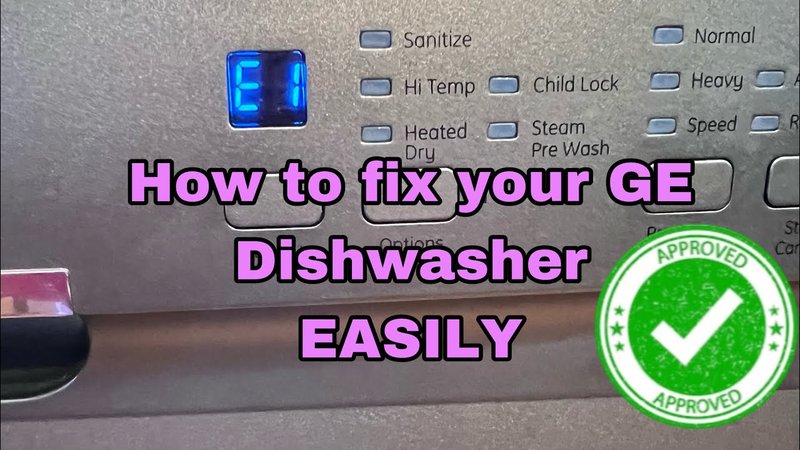
Error code E1 typically indicates an issue with water entering your dishwasher. Imagine trying to wash your dishes with hardly any water—it’d be like trying to take a shower with just a drizzle. Your dishwasher feels the same way when it displays E1. But don’t worry, preventing this error is simpler than it seems and doesn’t require a degree in appliance repair. With a few routine checks and a little upkeep, you can avoid seeing this error code over and over again.
Understanding the Causes of Error Code E1
The E1 error on a GE dishwasher is mainly about water supply issues. Think of it this way: your dishwasher needs a steady flow of water much like a plant that requires regular watering to thrive. When it doesn’t get what it needs, it shows the E1 code as a cry for help. This can happen due to a clogged or kinked water inlet hose, a malfunctioning water inlet valve, or even a problem with the water supply itself.
Start by checking the water inlet hose. This is like making sure your garden hose isn’t twisted or blocked when you’re trying to water plants. If the hose is kinked, gently straighten it out. If it’s clogged, cleaning it should do the trick. Next, you might want to look at the water inlet valve. This valve acts like a gatekeeper, letting water into your dishwasher. If it’s stuck or faulty, it’s as if the gate is closed or barely open, restricting water flow.
Lastly, consider your home’s water pressure. If your water pressure is weak, it’s like trying to fill a pool with a spoon—you’ll never get enough water into the dishwasher. Ensuring your home has adequate water pressure means your dishwasher can get all the water it needs to operate efficiently.
Routine Maintenance to Prevent Error Code E1
Preventing error code E1 starts with regular maintenance, much like keeping a car running smoothly with regular oil changes. One practical step is to routinely inspect the water inlet hose for any signs of damage or blockages. Think of it as checking your car’s tires for air; it’s a small task that can prevent big problems.
Another maintenance tip is to keep an eye on your dishwasher’s filters and clean them regularly. Filters can become clogged with food particles and debris over time, much like a drain that gets clogged with hair. Cleaning these filters ensures water can flow freely through your dishwasher.
Additionally, it’s wise to check the dishwasher’s internal parts, such as the spray arms and the door seals, for wear and tear. These parts are like the moving pieces in a clock; if one part is worn out, the whole system can suffer. By keeping these components in good condition, you help ensure your dishwasher operates without hiccups.
Simple Habits to Adopt for Your Dishwasher’s Health
Developing good habits with your dishwasher is akin to having a regular exercise routine for your own health. After each cycle, check inside the dishwasher for any leftover food debris. This is like wiping down your kitchen counters after cooking to prevent grime from building up.
Using the right type and amount of detergent can also make a difference. Too much detergent is like over-salting a dish—it doesn’t improve the clean and can actually cause more problems than it solves. Follow the manufacturer’s instructions on how much detergent to use, ensuring that your dishwasher’s performance is optimized.
Finally, consider running a cleaning cycle with vinegar and baking soda once a month. This acts like a spa day for your dishwasher, clearing out mineral deposits and giving it a fresh start. Just as you’d feel rejuvenated after a spa visit, your dishwasher will function better after a good clean.
When to Call in the Professionals
There are times when, despite your best efforts, that pesky E1 error just won’t go away. It’s like when you’ve tried every home remedy for a cold, but you’re still sniffling—sometimes you need a doctor. In the case of your dishwasher, that doctor is a professional appliance technician.
If you’ve checked all the easy fixes but the error persists, it might be time to call in the experts. Professionals have the tools and expertise to diagnose and fix more complex issues, such as electrical faults or internal component failures. Like hiring a skilled mechanic for your car, they can ensure your dishwasher is back to running smoothly in no time.
Remember, there’s nothing wrong with seeking professional help. It can save you time, and in the long run, money, by preventing further damage. After all, having peace of mind is priceless when it comes to home appliances.
In conclusion, while the E1 error on a GE dishwasher can be annoying, it’s not insurmountable. By understanding what causes it, maintaining your machine, adopting good habits, and knowing when to call a pro, you can keep your dishwasher in top shape and enjoy clean dishes without issue.